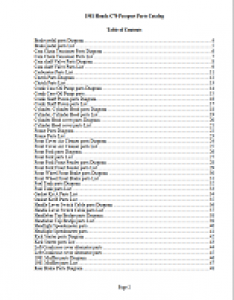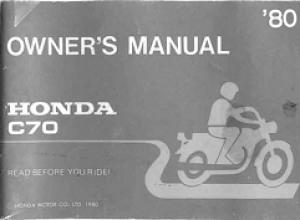Timing Adjustment
- Details
Adjusting Timing
http://ct90-ct110.com/Adjusting-Timing.html
NOTE: Start with a valve inspection and possible adjustment, if your CT is not operating properly, even if it seems your problem is not related to the valves! If you just purchased a CT, start with the valve inspection and adjustment just to make sure everything is OK or if the engine doesn't want to start or is not operating properly. The second step should be inspecting and/or adjusting the contact breaker points, you can then return here to inspect and/or adjust the timing.
There are two methods for inspecting and adjusting the timing;
- Static timing
- Dynamic timing
The simplist is static timing, however, static timing does not tell you how your timing advance mechanism is working, so the second method, dynamic timing is better, however, it is a little more complex.
Iginition Timing - Static Inspection
NOTE: Do not perform this process until the contact breaker points gap has been inspected and/or adjusted. CAUTION: Use care when inspecting and adjusting the timing, so as to NOT touch the contact breaker points with a metal object (like a screw driver). This could cause electrical failures.
You will need to have a static timing light to complete this process. You will most likely need to make one, because they are becoming hard to find. They are easy to make. Most CT's have a 6 volt electrical system, however, if you have a 12 volt CT, the only difference would be in the bulb and the socket for the bulb.
Get the following materials:
- A simple bulb, 6 volts (# 1129, this was a little hard to find) or 12 volts (easy to find, many types),
- A socket to hold the bulb,
- An 18 - 24 inch length of 2 strand, insulated wire, (table lamp wire, works, OK),
- 2 alligator clips.
Create your static timing light to look like what is in the drawing below.
Set up your static timing light on the contact breaker plate as shown below. One alligator clip is attached to the spring part of the contact breaker points and the other alligator clip is attached to the engine case as a ground to complete the electrical circuit.

Turn the key to the ON position.
Rotate the generator slowly in the counterclockwise (anti-clockwise) direction. Watch for the static timing light to initially turn on. Stop rotating the generator as soon as the static timing light turns on. See where the generator's "F" mark is located relative to the index mark.
NOTE: The "F" mark is NOT the "F" itself, but the slim straight mark to the left of the "F".The index mark on your CT may look slightly different than the drawing above, however, the index is usually on the right side or in the lower right area of the generator.
The drawing below shows the ideal of when the static timing light initially turns on, i.e., the "F" mark is aligned with the index mark.
If the "F" mark is located right at the index mark when the static timing light initially turns on, you are good to go!
Ignition Timing - Static Adjustment
If you need to adjust the timing...
Before you move the generator, you need to know where the "F" mark is in relation to the index mark when the static timing light initially turns on, so you can determin if you need to ADVANCE or RETARD the timing.
If the "F" mark is BEFORE the index mark when the static timing light initially turns on, you will need to RETARD the timing.
If the "F" mark is AFTER the index mark when the static timing light initially turns on, you will need to ADVANCE the timing.
Now that you know where the "F" mark is located when the static timing light initially turns on, you will need to align the "F" with the index mark, so you can either ADVANCE or RETARD the contact breaker points plate.
Rotate the generator counterclockwise to align the "F" mark with the index mark.
If the "F" mark was before the index mark, you will probably have to rotate the generator just a little way.
If the "F" mark was after the index mark, you wil have rotate the generator all the way around.
NOTE: Do not rotate the generator backwards to align the "F" mark with the index mark, the engine is designed to operate in one direction only!
Once the "F" mark is aligned with the index mark, go to the contact breaker points plate and loosen the contact breaker points plate locking screws. Notice in the drawing below that these locking screws are different screws than what was used for adjusting the points. They are farther to the outside of the contact breaker points plate.
If you need to RETARD the timing, use a flat blade screw driver to rotate the contact breaker points plate COUNTERCLOCKWISE (ANTI-CLOCKWISE), as shown in the drawing below, until the static timing light just turns off, then rotate the contact breaker points plate in the other direction until the static timing light just turns on again.
If you need to ADVANCE the timing, use a flat blade screw driver to rotate the contact breaker points plate CLOCKWISE, as shown in the drawing below, until the static timing light just turns on.
Tighten the contact breaker points plate locking screws securely, exercising care to not allow the contact breaker points plate to rotate.
Rotate the generator counterclockwise (anti-clockwise) several times, returning to the position where the static timing light initially turns on. If the position of the "F" mark is not aligned with the index mark, restart the process.
You now have properly adjusted static timing.
Ignition Timing - Dynamic Inspection (TBA)


